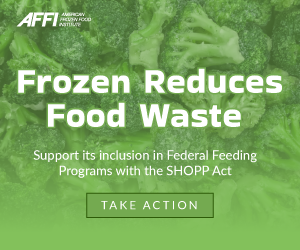During the American Frozen Food Institute (AFFI) AFFI-CON 2022, nearly 500 companies and more than 1,100 attendees gathered in Dallas, Texas to meet one-on-one and discuss current and future business opportunities. Sally Lyons Wyatt, IRI executive vice president and practice leader, kicked off the conference with a presentation on the State of Frozen Food and provided an in-depth review of the category’s 2021 performance and 2022 growth trends. The data is clear – frozen food has been a pandemic powerhouse and growth already outpaced total food and beverages in the three years preceding the pandemic.
2021 Performance
Going up against the biggest year in food retailing, frozen food sales in the traditional channels slowed to low single-digit growth in dollars and slightly below year-ago levels in units. However, dollars (+23.0%) and units (+18.0%) remained far ahead of the 2019 pre-pandemic normal. This is driven by above-average consumer demand and fueled by higher household penetration, more trips down the frozen food aisles, and higher spending per trip. E-commerce delivered an additional 12% boost, for an omni-channel frozen food category gain of 2% in dollars and -1.8% in units. Millennials, who represent about $23 out of every $100 food and beverage dollars, had a far greater contribution in frozen foods, especially in categories such as frozen fruit where they account for $31 out of every $100 spent. “Millennials love frozen foods,” said Lyons Wyatt. “Millennials view frozen food as convenient, fresh, and nutritious, and greatly appreciate the innovation the department brings every year.”
| Frozen foods 2021 | Vs. 2020 | Vs. 2019 |
| Dollars | +1.0% | +23.0% |
| Units | -3.2% | +18.0% |
Source: IRI, MULO, 52 weeks ending 12/26/2021
Supply Chain
2021 data indicate strong results in light of the supply chain challenges. As Lyons Wyatt put it, “we cannot sell what we do not have.” In-stock rates progressively worsened as 2021 went on. February 2021 was the high-water mark, with an in-stock position of 91.4%. November was the category’s lowest in-stock position, at 85.8%. “This means the resulting assortment has to work harder to achieve the same sales levels. With levels such as these, it is important to optimize product allocation, leverage the information to assess competitive risk and understand the potential loss of core buyers,” Lyons Wyatt explained.
Inflation
Inflation was one of the biggest stories affecting food retailing in 2021 and frozen food was no exception, though the experience was different than for other categories in the food and beverage sector. Frozen food had a 3.6% increase in the price per unit, which was far below the average across all foods and beverages, at more than 6.0%. This inflationary difference means that dollar sales for frozen did not experience the same sales bump as some of the other departments across the store, where inflation may have reached the high single-digit or even double-digit territory.
“Categories react differently to price increases, with negative sales impact in the event of price increases the strongest for poultry and pizza. The demand for breakfast foods, processed poultry, and dinners/entrees was fairly unaffected by the 2021 price increases,” shared Lyons Wyatt. Frozen fruit and vegetables proved to be more vulnerable to price increases and elasticity than fresh counterparts. “To hedge price increases, private label shares have been gaining, with the highest private-brand shares for frozen seafood and plain vegetables,” Lyons Wyatt added.
Convenience
The combined effect of new COVID-19 variants and inflation meant continued home-centric meal preparation. At the same time, Americans are tired of scratch cooking and seek a convenient meal planning, shopping, preparation, and cleanup process. This quest for convenience can be seen in an above-average performance for dinners/entrees, breakfast items, snacks, and appetizers — all focused on delivering convenient and balanced solutions across meal occasions.
Plant-Based Sales
Plant-based plays a role across the grocery store, representing 41% of general food dollars and 22% of frozen food. Unit sales of frozen plant-based items were down 3.5%. Frozen dinners, meat substitutes and desserts account for 87% of all plant-based frozen sales. Dinners and desserts grew year-on-year, but demand for meat alternatives has softened.
Frozen Fruit and Vegetables
The strong growth in frozen fruit and vegetables in 2020 brought a rising share of total produce dollars across the store. The share remained elevated in 2021. Frozen fruit had a small dollar increase, at +0.7% but could not quite reach the prior year levels in units and pounds — affected by an average in-stock rate of 90%. Mixed fruit items stood out as sales winners, a trend that is expected to continue in 2022. Frozen fruit also found pockets of growth in a number of sustainability-related claims, with above-average growth for recyclable and water conservation.
“Fruit has a distinct opportunity for continued growth,” said Lyons Wyatt. “Make the section easier to shop, with a good assortment and innovation in packaging and size. Entry price points and smaller bag options can be ideal to engage with smaller households and those with less freezer capacity.”
Future of Frozen
Looking ahead, preserving the enormous growth momentum in frozen food will require proactive in-stock management, addressing different needs and growth trends by channel, occasion-based and personalized promotions, and continued high levels of innovations. A full recording of Lyons Wyatt’s presentation, and additional educational content from AFFI-CON, is available to watch online.
Anne-Marie Roerink of 210 Analytics also contributed to this article.




